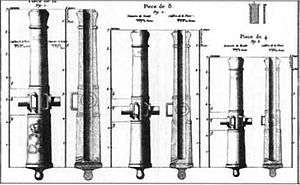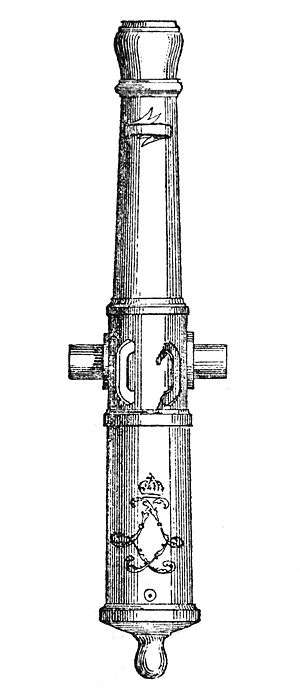Gribeauval system


The Gribeauval system (French: système Gribeauval) was an artillery system introduced by Lieutenant General Jean Baptiste Vaquette de Gribeauval during the 18th century. This system revolutionized French cannon, with a new production system that allowed lighter, more uniform guns without sacrificing range. The Gribeauval system superseded the de Vallière system. These guns contributed to French military victories during the Napoleonic Wars; the Gribeauval system was "arguably the best artillery system in Europe at that time".[1]
Development
The Gribeauval system was introduced through royal order on 15 October 1765.[2] Although much of the work is not directly attributable to Gribeauval (see Honoré Blanc), the systems of organization and uniformity in ordnance have been called le système Gribeauval.
Technology
Gribeauval's primary improvement came in the production of large artillery pieces. Prior to his improvements, guns were cast in a single piece by pouring molten iron or bronze around a clay cylinder core. After the metal cooled, the clay was removed, leaving the gun's bore. However, the clay cores resulted in imperfect bores, which prevented the use of tight-fitting cannonballs. Because rounds did not fit tightly, much of the explosive power of the gunpowder was lost.
Gribeauval created a new system of production, initially developed by Jean Maritz, casting guns as a single, solid block, and then drilling the bore on a large machine:[3] the entire barrel of the gun rotated against a massive drill bit, and the cutting head was advanced by means of weights and cogs. The resulting guns had a tighter manufacturing tolerance between the bore and ball. This allowed the gun barrels to be made thinner without sacrificing range and shorter without reducing accuracy. Both improvements reduced weight, which in combination with improved gun carriages designed by Gribeauval, allowed the new fieldpieces to be more easily moved about.
Organization and usage
Gribeauval developed comparatively light cannon used for field artillery::
- Short 12-pdr Canon de 12,
- Short 8-pdr Canon de 8,
- 4-pdr Canon de 4,
- 6.4-inch howitzer Obusier de 6 pouces Gribeauval,
The 1-pdr Rostaing gun and the Swedish 4-pdr Battalion Guns were retained from the previous system.[4]
For siege and garrison artillery he retained the same proportions as the earlier Valliere System of 1732 but with the removal of the decoration and simplification of the dolphins.
- 24-pdr Canon de 24
- 16-pdr Canon de 16
- Long 12-pdr Canon lourd de 12
- Long 8-pdr Canon lourd de 8.
Gribeauval also designed a range of mortars:
- 8 inches,
- short 10-inch (Mortier court de 10),
- long 10-inch (Mortier long de 10),
- 12-inch (Mortier de 12).[5] He also incorporated in his system an anti-personnel stone mortar of 15-inch from the de Vallière system.[5]
Only the Gribeauval siege guns were first used for major operations in the American Revolutionary War, in General Rochambeau's French expeditionary corps, from 1780 to late 1782, and especially at Yorktown in 1781.[6] Rochambeau's French Infantry were equipped with Regimental Swedish 4-pdrs and not, as many think, Gribeauval 4-pdrs.
It was used extensively during the wars following the French Revolution and in the early Napoleonic wars supplemented by large numbers of captured ordnance, including Austrian, Hanoverian, Piedmont and Prussian.
From 1805, the Year XI system started to replace the captured ordnance. Gradually the Gribeauval 4-pdr and 8-pdr was replaced by the Year XI 6-pdr and the Gribeauval 6-pouce (6.4-inch) Howitzer was replaced by the Year XI 24-pdr howitzer. In 1808, due to financial considerations, the obsolete Gribeauval carriages were cannibalised to create new carriages for the Year XI gun tubes.[7]
Improvements and obsolescence

The Gribeauval system was replaced by Napoleon I in 1803 by the Year XI system. This took many years and only after the 1809 campaign was the Gribeauval system entirely superseded. Only the Gribeauval 12-pdr was retained in the new system. From 1808, the metalwork, axles and wheels from the Gribeauval 8-pdr were used to make carriages for the Year XI 6-pdr. Due to the abundance of Spanish Gribeauval Ordnance, artillery of the Gribeuaval System was still occasionally used by the French. In 1812, the Gribeauval 4-pdrs were used as the Regimental Artillery for the Young Guard in the Invasion of Russia.
Under the Bourbon Restoration in 1815, the Gribeauval System was officially reinstated but the Year XI ordnance was still in use.
Between 1825 and 1831, Sylvain Charles Valée made further technical improvements to the Gribeauval system. The "Valée system" was used at the Capture of Algiers (1830), the Fall of Constantine (1837), and in the Crimean War (1853–1856).
A new generation of shell-firing canon obusiers emerged with the invention of the naval shell-gun by Paixhans in 1823, and the introduction of the canon obusier de 12 in 1853 by the French Army; this rendered the Gribeauval system obsolete.
See also
![]() Media related to Gribeauval system at Wikimedia Commons
Media related to Gribeauval system at Wikimedia Commons
Notes
References
- Chartrand, René 2003 Napoleon's guns 1792-1815 (1) ISBN 1-84176-458-2 Osprey Publishing
- Chartrand, René 2003 Napoleon's guns 1792-1815 (2) ISBN 1-84176-460-4 Osprey Publishing
- Dawson, A.L., Dawson P.L. and Summerfield S. (2007) Napoleonic Artillery, Crowood Press, ISBN 978-1-86126-923-2
- Graves, Donald (2011) "Louis de Tousard and his "Artillerists Companion": An Investigation of Source Material for Napoleonic Period Ordnance", Smoothbore Ordnance Journal, pp. 88–97, ISBN 978-1-907417-13-9
- Puységur in Journal de Paris, supplement of July 8, 1789; Chevalier de Passac, Précis sur M. de Gribeauval (Paris, 1816); Veyrines, Gribeauval (Paris, 1889), Hennbert, Gribeauval, lieutenant-général des armées du roy (Paris, 1896).
- Smith, Digby (trans.) (2011) "The 18 Questions on Austrian Artillery that Gribeauval Answered in his report Dated March 1762," Smoothbore Ordnance Journal, Issue 1, pp60–65, ISBN 978-1-907417-13-9
- Summerfield, Stephen (2011) "Summary of Gribeauval's Life," Smoothbore Ordnance Journal, Issue 2, pp9–23, ISBN 978-1-907417-14-6
- Summerfield, Stephen (2011) "Gribeauval Garrison Carriage," Smoothbore Ordnance Journal, Issue 2, pp36–56, ISBN 978-1-907417-14-6
![]() This article incorporates text from a publication now in the public domain: Chisholm, Hugh, ed. (1911). "article name needed". Encyclopædia Britannica (11th ed.). Cambridge University Press.
This article incorporates text from a publication now in the public domain: Chisholm, Hugh, ed. (1911). "article name needed". Encyclopædia Britannica (11th ed.). Cambridge University Press.

